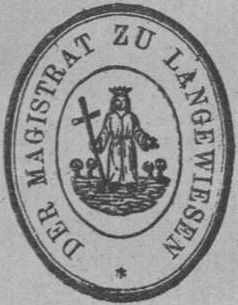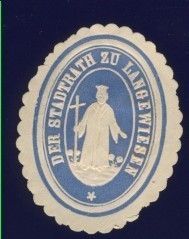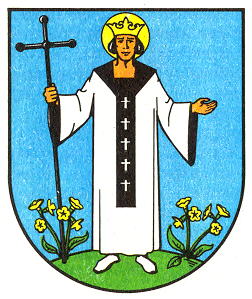Langewiesen: Difference between revisions
Jump to navigation
Jump to search
Knorrepoes (talk | contribs) m (Text replacement - "===Origin/meaning=== The" to "===Origin/meaning=== The") |
Knorrepoes (talk | contribs) m (Text replacement - "|center|Wappen von {{PAGENAME}}]] " to "|center|alt=Wappen von {{PAGENAME}} / Arms of {{PAGENAME}}]] ") |
||
| Line 8: | Line 8: | ||
Incorporated into : 2018 [[Ilmenau]] | Incorporated into : 2018 [[Ilmenau]] | ||
[[File:langewie.jpg|center|Wappen von {{PAGENAME}}]] | [[File:langewie.jpg|center|alt=Wappen von {{PAGENAME}} / Arms of {{PAGENAME}}]] | ||
{| class="wikitable" | {| class="wikitable" | ||
Revision as of 11:36, 16 August 2022
This page is part of the German heraldry portal |
Heraldry of the World |
|
German heraldry:
|
Selected collector's items from Germany:
|
LANGEWIESEN
State : Thüringen
District (Kreis) : Ilm-Kreis
Additions : 1994 Oehrenstock
Incorporated into : 2018 Ilmenau
| German | In Gold die heilige Margarethe mit silbernem Kleid, rotem Gewand und goldener Krone auf einem grünen Hügel stehend, in der Rechten einen schwarzen Kreuzstab haltend. |
| English | No blazon/translation known. Please click here to send your (heraldic !) blazon or translation |
Origin/meaning
The arms were officially granted on September 30, 1993.
The arms are based on a 15th century seal of the city, which also showed a crowned female figure holding a staff. The figure most likely symbolises St. Margareth, the old patron saint of the local church. Later seals and images showed a male figure, but in 1993 the historical image was restored.
| The municipal stamp shown in 1892 |
Seal of the city from around 1900. |
| The arms by Hupp in the Kaffee Hag albums +/- 1925 |
The arms in 1984 |
Contact and Support
Partners:
Your logo here ?
Contact us
© since 1995, Heraldry of the World, Ralf Hartemink 
Index of the site
Literature : Hupp, O: Kaffee Hag albums, 1920s; Benzing et al, 1984; Ulle, 1997
















